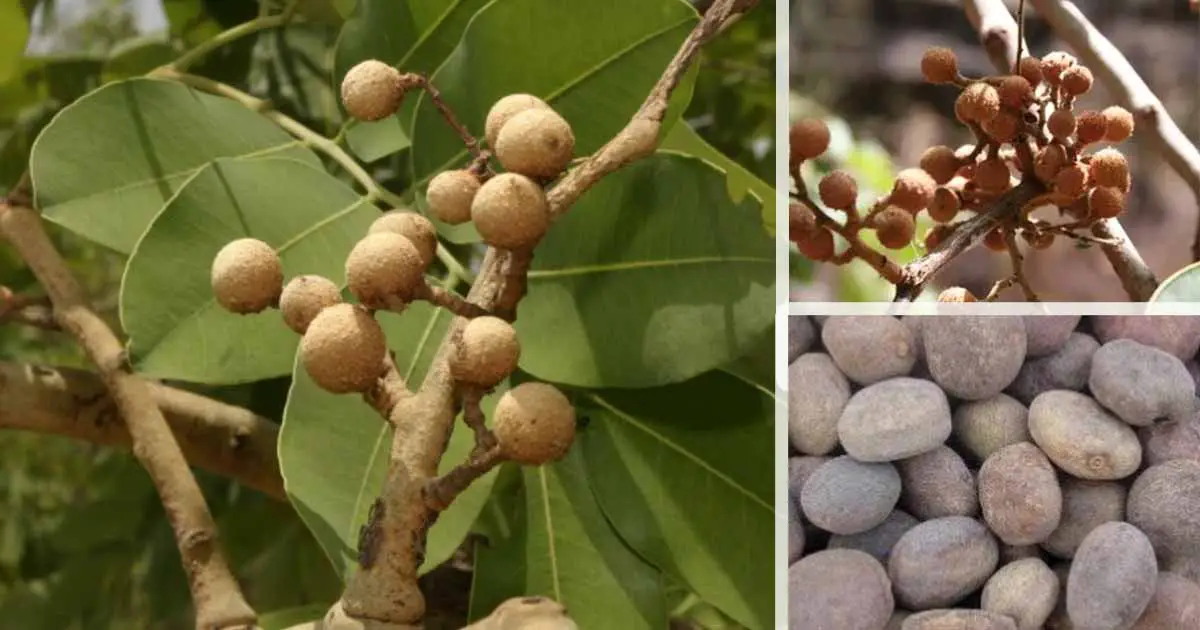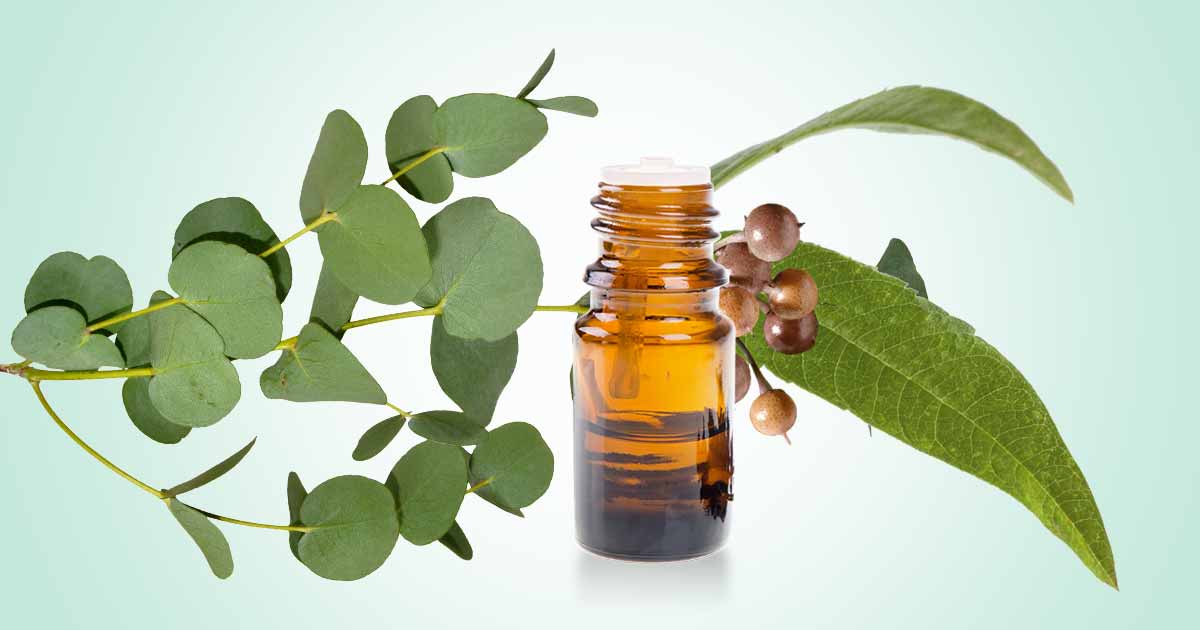Detarium microcarpum, also called sweet detar, small detar, tallow tree, is a tropical plant that belongs to the leguminosae family, Caesalpiniaceae. Sweet detar fruit has an edible pulp and seed. The pulp is a rich source of minerals, sugar, and vitamin C. The seed contains many nutritional compositions, and hydrocolloids which impacts a good binding and thickening capabilities.
Detarium microcarpum is a shrub having an irregular crown, and can grow up to 5-10 m high. The leaves are paripinnate or imparipinnate, with alternate or sub-opposite leaflets. The bark is reddish-brown, clear, smooth, and greenish yellow on young shoots. The fruit is a globular or sub globular, flattened drupe. The fruit epicarp is dark green when immature, light green to brown when mature.
The mesocarp or pulp which is the edible portion of the fruit is greenish, and intermingled with fibers inserted on the stone. The stone is woody, covered with fibrous meshes and contains a single ovoid and fattened dark brown seed.
The fruit of Detarium microcarpum is rich in minerals (like potassium, magnesium), sugar, and vitamin C, while the seed can be a good stabilizer or thickening agent, as it has good foaming, swelling, water and oil absorption, and emulsion capacity.
Other names of sweet detar (Detarium microcarpum) include tallow seed, “sweet dattock”, “Détar sucré” or “petit Détar” in French, “Ofo” in Igbo, Nigeria, “Abu Laila”, in western Sudan, “tamba dala” in Mali, “dank” in Senegal.
In traditional medicine, sweet detar (Detarium microcarpum) is used to treat fever, meningitis, malaria, diabetes, malaria, diarrhea, convulsion, bacterial and fungal infections. The fresh bark or leaves powder is used for wound treatment. Infusion of the bark has anti-inflammatory, antiparasitic, and diuretic effects. It is used to treat diarrhea, measles, anemia, and syphilis. The leaves are used to treat cramps, as an enema for diarrhea, an eye wash for conjunctivitis, and for itching. The heated root is used to repel mosquitoes.
The fruit pulp and seed of sweet detar (Detarium microcarpum) has been used to make several food products. The powder extract from the pulp is used to make juice and jams in Sudan. The seed powder of sweet detar is also used as a stabilizer in pineapple jam, mango and orange juices, tomato sauces. The gum from the seed also a stabilizer in white bread, raw beef burger and ice cream.
Mineral Composition
The pulp and seed has similar carbohydrates’ composition.
Fruit Pulp
The fruit pulp of sweet detar contains 2.9-6.1% proteins, 0.7-2.2% fats, 12.2% fiber, 40.1-65.4% carbohydrates, 2.6% ash, 7.1-12.2% moisture, and 239.4-241.0 kCal of energy (Nutritional properties of Detarium microcarpum fruit pulp, Umaru et al., 2007; Kouyate et al., 2009; Kini et al., 2010; Florence et al., 2014; Makalao et al., 2016)
The fruit also contains potassium (1017.0 mg per g), calcium (26.2-43.0 mg), sodium (112.0 mg), iron (47.3-106.3 mg), zinc (5.9-9.9 mg), magnesium (51.3-84.0 mg), phosphorus (9 mg), copper, nickel, cobalt, and aluminum.
The vitamins include vitamin C (4.6-4.7 mg), vitamin E (1.2 mg), vitamin K (312.2 ug), B2, β-Carotene (312.7 ug).
Seed
The raw seed of sweet detar (Detarium microcarpum) contains 7.2-16.7% of moisture, 52.2-57.0% of carbohydrates, 12.6% of proteins, 7.6% of fats, 5.3% of crude fiber, 4.5% of ash, and 341.1-396.1 kCal of energy ((Obun et al., 2009; Uhegbu et al., 2009; Amandikwa et al., 2017; Peace et al., 2018; Michael et al., 2019).
The seed also contains minerals such as potassium, magnesium, calcium, phosphorus, sodium, iron, zinc, manganese, and vitamins such as ascorbic acid, thiamine, and niacin.
However, there are antinutrients such as phytic acid, tannins, oxalates, and cyanides in both fruit pulp and seeds. Processing treatment of the seeds such as roasting, soaking, fermentation, and boiling reduces the antinutrients.
Bioactive Compounds
Detarium microcarpum contains saponins, tannins, alkaloids, phenolic compounds, steroids. Some new compounds isolated from the plant includes a new labdane diterpenoid, microcarpin, and one new ceramide derivative, microcarpamide. Others are 5-(carboxymethyl)-5,6,8a-trimethyl-3,4,4a,5,6,7,8,8a-octahydronaphthalene-1-carboxylic acid, microcarposide, rhinocerotinoic acid, 1,7-dihydroxy-6-methylxanthone, ursolic acid, 3β,23-dihydroxylup-20 (29)-en-28-oic acid, alphitolic acid, and stigmasterol glucoside (William Fouatio Feudjou et al., 2021)
The seed hydrocolloids contain fatty acids, phenolic compounds, alcohols, esters, hydrocarbons, aldehydes, and aromatic compounds. Due to the rich hydrocolloids (water-soluble non-starch polysaccharides and proteins) content in the seed, it can serve as a thickening and gelling agent.
The seed also contains beta-carotene, plant sterols, phospholipids, glycolipids, and fatty acids such as oleic acid, behenic acid, palmitic acid, and lignoceric acid.
Phytochemical Constituents of Detarium microcarpum
- Fatty acids: unsaturated fatty acids like palmitic, linoleic, and oleic acids
- Phenolic compounds: Gallic acid, myricetin 3-O-rhamnoside, quercetin 3,7-O-dirhamnoside, quercetin 3-O-glucoside, and quercetin 3-O-rhamnoside, luteolin, epicatechin, methyl gallate.
- Terpenoids: lupeol, Lup-20 (29)-ene-2alpha,3beta-diol, Betulinic acid, 13E-Clerodien-15-oic acid.
- Organic compounds: protocatechuic acid, hexanedioic acid, Docosanoic acid.
- Phytosterols: campesterol, stigmasterol, β-Sitosterol glucoside
- Sugars: myo-inositol, sucrose
- Essential oils: The leaves contain linalool, geraniol, safranal, borneol, myrcene, 3-octanone, α-Terpineol, α-Cubebene, neryl acetone, caryophyllene oxide, humulene-1,2-epoxide, β-Caryophyllene, γ-muurolene, β-selinene, γ-cadinene, α-Copaene, germacrene-D, δ-cadinene.
Health Benefits of Sweet Detar (Detarium microcarpum)
Antioxidant effect:
Detarium microcarpum leaves contain polyphenols and flavonoid compounds such as quercetin 3-O-glucoside, gallic acid, myricetin 3-O-rhamnoside, quercetin 3, 7-O-dirhamnoside, and quercetin 3-O-rhamnoside. The stem extract also exhibit both antioxidant and hepatoprotective effect.
These compounds exhibit free radical scavenging capacity. Antioxidants play a role in the prevention of chronic diseases like diabetes, cancer, and coronary heart disease.
Anti-diabetic effect:
The root extract reduced blood sugar levels in alloxan diabetic rats (Okolo C. E., et al., 2012). Studies reveals the trunk bark contains myo-inositol, D-(-)-bornesitol, L-quino-1,5-lactone, D-pinitol, sucrose, D-glucose, and D-fructose. D-pinitol and the derivatives prevent insulin resistance.
The seed extracts lower blood sugar, postprandial glucose levels, and cholesterol levels significantly. In a study by EA Irondi, et al., the extracts of Brachystegia eurycoma and Detarium microcarpum seeds flours inhibit key enzymes such α-amylase, α-glucosidase and aldose reductase (AR) which are linked with the development of type 2 diabetes (T2D).
Studies suggest that detarium gum from the plant has anti-diabetic effect, and is a superior excipient for the formulation of metformin mucoadhesive delivery systems (Adikwu M. U., et al., 2004)
Antimicrobial property:
The stem bark inhibit bacteria such as S. aureus, E. coli, Listeria monocytogenes, Pythium aphanidermatum. Some compounds in the extract such as caryophyllene oxide, a isovaleronitrile diglycoside called microcarposide, neryl acetone-caryophyllene, betulinic acid, β-sitosterol glucoside, methyl gallate, humulene-1,2-epoxide, lupeol, salvia-4 (14)-ene1-one, are thought to be responsible for the antibacterial effect.
Another study reported that the extracts of B. pinnatum and D. microcarpum inhibit Mycobacterium tuberculosis (Joseph AO.Olugbuyiro et al., 2012). Isolated compounds from the plant such as microcarpamide, microcarposide, and rhinocerotinoic acid inhibit salmonella strains such Salmonella typhi, Salmonella enteritidis and Salmonella typhimirium. This suggests activity against typhoid infection (WF Feudjou, et al., 2020).
As an antifungal agent, the stem bark extract inhibit Microsporum canis. Compound isolated from the extract, like clerodane diterpenes exhibit antifungal effect.
The stem bark extracts also inhibit hepatitis C virus (Olugbuyiro J., 2009).
Anti-inflammatory action:
The leaf and stem bark extracts of D. microcarpum have anti-inflammatory properties. The stem bark reduced the size of the rat paw in the carrageenan-induced inflammation (Yaro A., et al., 2017). Also, the leaf extract showed a significant dose-dependent anti-inflammatory effect against egg albumin and formalin-induced inflammation (Estella O. U., et al., 2020).
D. microcarpum contains compounds such as gallic acid (antioxidant, anti-inflammatory, anticancer), and polyphenolic compounds with antioxidant and anti-inflammatory effects such as vanillic acid, gallic acid, and protocatechuic acid.
Anticancer property:
The Stem bark extracts of Detarium microcarpum exhibit antioxidant and antiproliferative effects. It also inhibits angiogenesis and induce apoptosis. The extract inhibited HeLa cell proliferation, osteosarcoma cells.
Antidiarrheal effect:
Detarium microcarpum decoction is used traditionally to treat diarrhea. The extract protected against castor oil induced diarrhoea, and reduced intraluminal fluid volume (M.B. Tijjani, et al., 2013).
Anti-acetylcholinesterase activity:
The stem extract of Detarium microcarpum reduced the contractile amplitude in an isolated jejunal segment treated with acetylcholine. Hence, it could be effective in managing Alzheimer’s disease, a disease treated with acetylcholinesterase (AChE) inhibitors.
Antiparasitic effect:
The methanol leaf extracts of Detarium microcarpum exhibit antiplasmodial activity in mice infected with chloroquine sensitive Plasmodium berghei-berghei by significantly prolonging the survival time of the treated mice (AR Abdullahi, et al., 2020).
Detarium microcarpum leaves extract reduced the level of parasitaemia in Trypanosoma congolense infected rats. However, it did not reduce the trypanosome-induced anemia, hepatomegaly and splenomegaly.
The stem bark extracts inhibited the larval movement in Caenorhabditis elegans, a free living nematode, and could have synergistic effect when combined with ivermectin (Gagman H. A., et al., 2021). The larvicidal activity could be through breaking of cell membrane, and inducing cell death.
Insecticidal effect:
Constituent of the volatile oils of sweet detar such as 3,13E-clerodien-15-oic acid, 4 (18)-clerodien-15-oic acid, 18-oxo-3,13E-clerodien-15-oic acid, and 2-oxo-3,13E-clerodien-15-oic acid that may exhibit insecticidal and pesticidal property.
The extract of the root bark is toxic to T. casteneum, the red flour beetle.
Toxicity
The methanolic extract of the leaf of Detarium microcarpum is safe even at the dose of 5000 mg/kg. The seed diet or seed flour does not cause any changes on haematological or biochemical indices. However, long-term use of the stem bark extract may have negative effect on the organ. It resulted to lethality in mice at the dose of 2900 mg/kg and 1600 mg/kg body weight.
Sweet detar also contains antinutrients which may slow the absorption of some nutrients in the body. Processing treatment can reduce the antinutrients significantly.
References:
- https://www.researchgate.net/profile/Idris-Sadiq/publication/351269234_ANTITRYPANOSOMAL_POTENTIAL_OF_METHANOLIC_EXTRACT_OF_DETARIUM_MICROCARPUM_LEAVES_IN_TRYPANOSOMA_CONGOLENSE_INFECTED_RATS/links/608e9dab92851c490faed958/ANTITRYPANOSOMAL-POTENTIAL-OF-METHANOLIC-EXTRACT-OF-DETARIUM-MICROCARPUM-LEAVES-IN-TRYPANOSOMA-CONGOLENSE-INFECTED-RATS.pdf
- https://scialert.net/abstract/?doi=jms.2013.477.482
- https://core.ac.uk/download/pdf/32227159.pdf
- https://www.ncbi.nlm.nih.gov/pmc/articles/PMC9569227/#B56
- https://doi.org/10.1515/znc-2021-0239












